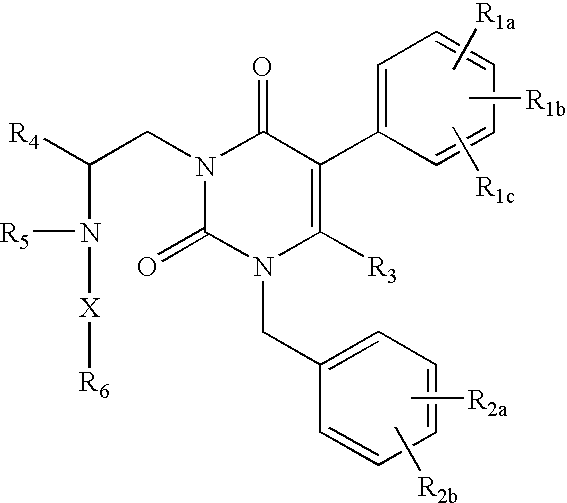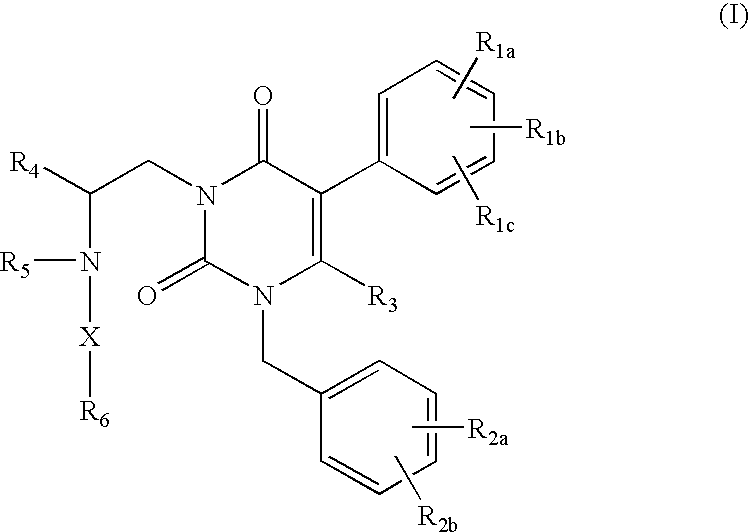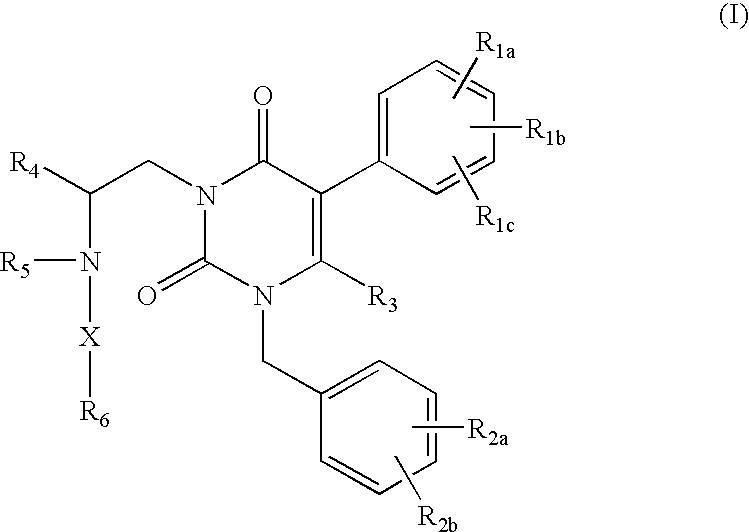Gonadotropin-releasing hormone receptor antagonists and methods relating thereto
a technology of gonadotropin and receptor, which is applied in the direction of biocide, drug composition, immunological disorders, etc., can solve the problems of life-threatening conditions and inability to inhibit enzymes
- Summary
- Abstract
- Description
- Claims
- Application Information
AI Technical Summary
Benefits of technology
Problems solved by technology
Method used
Image
Examples
example 1
3-[2(R)-{hydroxycarbonylpropyl-amino}-2-phenylethyl]-5-(2-fluoro-3-methoxyphenyl)-1-[2-fluoro-6-(trifluoromethyl)benzyl]-6-methyl-pyrimidine-2,4(1H,3H)-dione
Step 1A: Preparation of 2-fluoro-6-(trifluoromethyl)benzylamine 1a
To 2-fluoro-6-(trifluoromethyl)benzonitrile (45 g, 0.238 mmol) in 60 mL of THF was added 1 M BH3:THF slowly at 60° C. and the resulting solution was refluxed overnight. The reaction mixture was cooled to ambient temperature. Methanol (420 mL) was added slowly and stirred well. The solvents were then evaporated and the residue was partitioned between EtOAc and water. The organic layer was dried over Na2SO4. Evaporation gave 1a as a yellow oil (46 g, 0.238 mmol). MS (CI) m / z 194.0 (MH+).
Step 1B: Preparation of N-[2-fluoro-6-(trifluoromethyl)benzyl]urea 1b
To 2-fluoro-6-(trifluoromethyl)benzylamine 1a (51.5 g, 0.267 mmol) in a flask, urea (64 g, 1.07 mmol), HCl (conc., 30.9 mmol, 0.374 mmol) and water (111 mL) were added. The mixture was refluxed for 6 hours. ...
example 2
3-[2(R)-{hydroxycarbonylpropyl-amino}-2-phenylethyl]-5-(2-chlorophenyl)-1-[2-fluoro-6-(trifluoromethyl)benzyl]-6-methyl-pyrimidine-2,4(1H,3H)-dione
Step 2A: Preparation of 5-bromo-1-[2-fluoro-6-(trifluoromethyl)benzyl]-6-methyl-3-[2(R)-amino-2-phenylethyl]-pyrimidine-2,4(1H,3H)-dione 2a
5-Bromo-1-[2-fluoro-6-(trifluoromethyl)benzyl]-6-methyl-3-[2(R)-tert-butoxycarbonylamino-2-phenylethyl]-pyrimidine-2,4(1H,3H)-dione 1e was dissolved in 20 mL / 20 mL CH2Cl2 / TFA. The resulting yellow solution was stirred at room temperature for 2 hours. The volatiles were evaporated and the residue was partitioned between EtOAc / sat. NaHCO3. The organic phase was dried over Na2SO4. Evaporation gave 2a as a yellow oil.
Step 2B: Preparation of 5-(2-chlorophenyl)-1-[2-fluoro-6-(trifluoromethyl)benzyl]-6-methyl-3-[2(R)-amino-2-phenylethyl]-pyrimidine-2,4(1H,3H)-dione 2b
To compound 2a (40 mg, 0.08 mmol) in 0.25 mL / 0.75 mL of H2O / dioxane in a 4 mL vial was added 2-chlorophenyl boronic acid (0.12 mmol) and...
example 3
3-[2(R)-{2-[5-tetrazoylpropyl]-amino}-2-phenylethyl]-5-(2-fluoro-3-methoxyphenyl)-1-[2-fluoro-6-(trifluoromethyl)benzyl]-6-methyl-pyrimidine-2,4(1H,3H)-dione
Step 3A: 3-[2(R)-{3-cyanopropyl-amino}-2-phenylethyl]-5-(2-fluoro-3-methoxyphenyl)-1-[2-fluoro-6-(trifluoromethyl)benzyl]-6-methyl-pyrimidine-2,4(1H,3H)-dione 3a
Compound 1f (110 mg, 0.2 mmol) was dissolved in acetonitrile (5 mL) and diisopropylethyl amine (52 mg, 0.4 mmol) was added, followed by the addition of 4-bromobutyronitrile (90 mg, 0.6 mmol). The reaction mixture was refluxed for 16 hours. Volatiles were evaporated and the residue was purified by flash chromatography (silica, 5% MeOH / CH2Cl2) to give compound 3a (115 mg, 94%). MS (CI) m / z 613.3 (MH+).
Step 3B: 3-[2(R)-{2-[5-tetrazoylpropyl]-amino}-2-phenylethyl]-5-(2-fluoro-3-methoxyphenyl)-1-[2-fluoro-6-(trifluoromethyl)benzyl]-6-methyl-pyrimidine-2,4(1H,3H)-dione 3-1
A solution of 3a (38 g, 0.06 mmol) in toluene (5 mL) was added tributyltin azide (42 mg, 0.12 mmol...
PUM
| Property | Measurement | Unit |
|---|---|---|
| Composition | aaaaa | aaaaa |
| Structure | aaaaa | aaaaa |
| Acidity | aaaaa | aaaaa |
Abstract
Description
Claims
Application Information
 Login to View More
Login to View More - R&D
- Intellectual Property
- Life Sciences
- Materials
- Tech Scout
- Unparalleled Data Quality
- Higher Quality Content
- 60% Fewer Hallucinations
Browse by: Latest US Patents, China's latest patents, Technical Efficacy Thesaurus, Application Domain, Technology Topic, Popular Technical Reports.
© 2025 PatSnap. All rights reserved.Legal|Privacy policy|Modern Slavery Act Transparency Statement|Sitemap|About US| Contact US: help@patsnap.com



